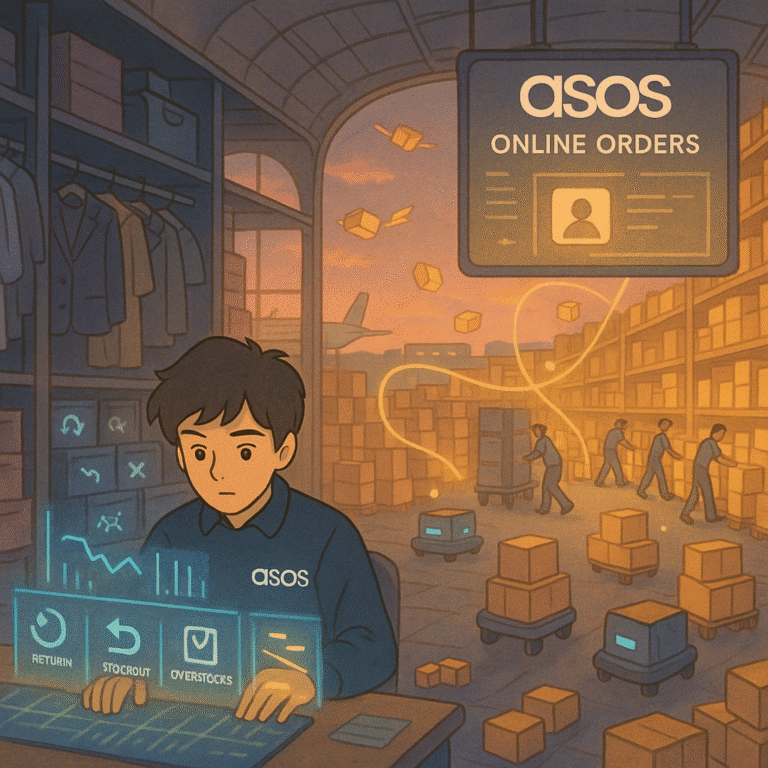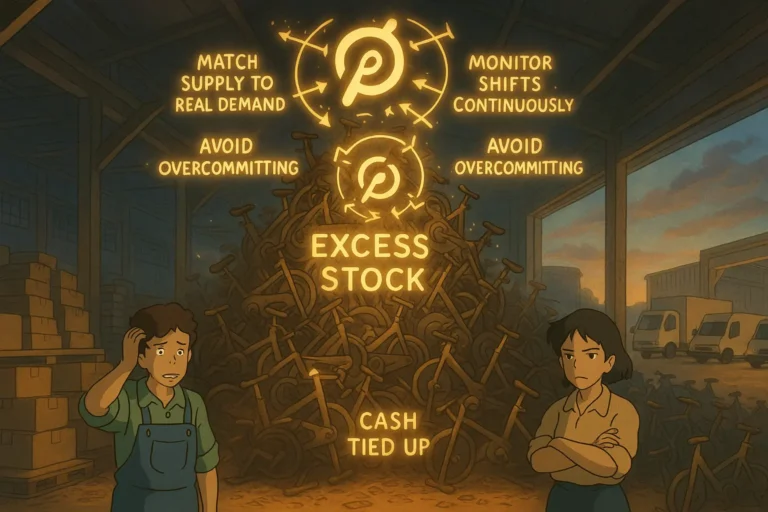
Like the rest of the world, supply chains in Africa are susceptible to inventory stockouts, especially when considering unique challenges on the continent.
The thing is, it doesn’t take a lot to unravel.
Does that mean you should let your supply chain get to the point where there are no inventories to sell to your customers? Definitely not.
As much as it is easy to get into the trap of stockouts, preventing it can be easier if you do things right. This is the crux of the article.
You will find out what it is, the causes, how to prevent it, and how to manage it.
What are Inventory Stockouts?
Inventory stockouts are situations where your organization or supply chain runs out or is about to run out of inventory while under a barrage of customer demands for the same inventory.
Stockout is the opposite of overstock, which is an event that occurs when there is too much inventory and very few demands. However, they are equally devastating to your supply chain.
Stockouts can occur from a shortage of raw materials or finished goods. It could also be a long-term or a short-term issue, depending on how you handle your operations and stock replenishments.
Impacts of Inventory Stockouts in Africa
Having stockouts can negatively impact your supply chain in various forms. We look at some of them here.
𝟏. 𝐋𝐨𝐬𝐬 𝐨𝐟 𝐑𝐞𝐯𝐞𝐧𝐮𝐞: This can result from a lack of potential sales of that inventory, which impacts the profitability of your supply chain and business.
𝟐. 𝐂𝐮𝐬𝐭𝐨𝐦𝐞𝐫 𝐃𝐢𝐬𝐬𝐚𝐭𝐢𝐬𝐟𝐚𝐜𝐭𝐢𝐨𝐧: Customers don’t like it when your supply chain fails to meet demands. This will make them turn to your competitors, affecting their loyalty towards your business.
𝟑. 𝐈𝐧𝐜𝐫𝐞𝐚𝐬𝐞𝐝 𝐂𝐨𝐬𝐭: When there is a stockout, your supply chain will often want to bridge that gap immediately, which leads to rash decisions and increased costs because of the urgency of demand.
𝟒. 𝐑𝐞𝐩𝐮𝐭𝐚𝐭𝐢𝐨𝐧𝐚𝐥 𝐃𝐚𝐦𝐚𝐠𝐞: When you cannot meet customer’s demand repeatedly, it creates a negative narrative about your business and supply chain.
What are the causes of Inventory Stockout in Africa?
There are several reasons why your supply chain or business might experience an inventory stockout situation within the continent.
1. Late Delivery From Suppliers
Late delivery or poor lead times are one of the major consequences of stockouts from suppliers.
This is especially the case when the expected supply is raw materials that would help facilitate the production of finished goods.
For instance, a soap manufacturing plant needs base oil, a derivative of crude oil, to help produce soaps. When the delivery of the product is delayed, it jeopardizes the entire operation.
There are many reasons why a supplier will delay. Sometimes, it is your supply chain’s fault, or it is from the suppliers. It could often be due to the poor business climate, such as infrastructural challenges.
Poor communication or late order requests between you and your suppliers make it difficult to meet the demands on time. Sometimes, when your supplier lacks capacity, getting them to respond on time can be challenging.
To fix these issues, focus on partnering with vendors who can take on your demands, but you also need to ensure proper communication.
2. Inadequate Safety Stocks
Safet stocks serve as a buffer between your inventory’s supply and demand. It helps your supply chain get over the hump when there is too much demand for your current ability to supply.
However, it can be insufficient in many cases, especially for small businesses or organizations just starting out. This is primarily because of the cost of holding inventory.
Still on the example of the soap manufacturer. There are many raw materials required to produce a piece of soap. These raw materials can be direct or indirect.
For example, power supply is an issue in many African countries, meaning businesses must provide it for themselves. They are indirect raw materials.
Typically, businesses use high-capacity generators, which require diesel to run.
When there is no gas or diesel, production cannot happen. But the thing is, holding diesel in inventory can be very expensive. So, most of these businesses hold a small amount, which would certainly not be enough when there is a supplier delay.
3. Poor Demand Forecasting
To a large extent, demand forecast determines the investment into production and supply of inventory. When this demand is inaccurate, it often leads to poor demand, creating the challenge of stockouts.
Poor demand forecasting is rampant across the continent because many businesses or supply chains do not invest in the technology and tools that help combat these.
Why?
Businesses already spend a lot of their capital trying to navigate the cost of infrastructural challenges and bad policies on the continent.
This huge cost makes it difficult for many, especially small businesses, to channel the capital resources needed to buy and adopt supply chain technology.
These technologies are responsible for demand forecasting, automation, order processing, etc.
When there is a lack of technology, these supply chains are stuck doing things the traditional way. You can combat these with access to finance, but getting those finances can also be quite an ordeal.
4. Low Capital or Finance
Capital or finance can be difficult to come by in Africa. There are many reasons for this, but it is often due to the high risks financial institutions face, making them very selective and charging exuberant interest rates.
Not many supply chains or businesses can survive these, especially when they cannot pass it on to the consumers. It inadvertently leads to a conservative approach to the management of resources.
Many times this will often lead to stockouts.
How to Manage Inventory Stockouts in Africa
Although inventory stockouts usually signal a much larger issue with the supply chain, there are certain ways businesses and supply chains can manage the situation.
Remember, properly managing stockout situations can make all the difference, especially for how your suppliers react.
1. Make the Request Unavailable
This typically affects e-commerce businesses and online retail stores on the continent.
When there is a shortage of goods, the ideal thing to do is immediately remove that order request from the website. When customers cannot make a request, they have little to no expectations of your business.
However, it makes them consider your competition, and you certainly don’t want to lose even one business. It could spell the end of customer’s loyalty to your brand or business.
The same applies to traditional business within the continent but on a more verbal scale. This means no promotional or acceptance of the product order until it is available.
2. Switch to Pre-Order
As I mentioned earlier, there is a risk with making orders or requests for products unavailable. It forces your consumers to seek out your competition.
To avoid that, you can switch the order to a pre-order model, which allows you delay or give you some more time to meet your customer’s demands.
Now, it won’t take care of all the customers. It would be false to assume that. But it will certainly keep enough of them, especially the loyal ones.
3. Offer Alternative Products
Another option is to offer alternative product options to the consumers. This is possible when similar SKUs are in your inventory, and you know they could work almost or just as well.
However, be sure to explain the shortcomings to consumers to prevent them from thinking you lied or actively tried to deceive them.
For instance, the Camry and Corolla are different products under the Toyota brand but offer similar solutions to the consumer.
Pitching one as an alternative to a consumer may not be so bad, but you must be open about the differences.
How to Prevent Inventory Stockouts in Africa
Yes, it is easy to fall into the trap of inventory stockouts considering the continent’s shortcomings, but preventing it is just as easy.
At least for the businesses that have done it in the past.
1. Build Better Supplier Relationships
In previous articles, I have mentioned how organizations and their suppliers face the same problem in Africa. One is just better at navigating it than the other.
Building a better supplier relationship is mostly about fixing the flow of information between both parties.
I have seen situations where a supply chain would have a need but misinform the vendors or, in many cases, wait too long to place an order because of finances or some other issue.
These moves usually result in delays, which cost the supply chain quite a lot of money. However, this could have easily been fixed by taking proactive actions.
Often, stockouts result from poor communication between your supply chain and its vendors. However, bridging that gap is possible.
Here are my tips to ensure free-flowing information between your supply chain and its vendors.
- Always be accurate
- Place orders on time
- Be truthful about payment terms
- Be specific about demand requirements
- Enforce policies and terms in the contract.
Doing these goes a long way to prevent inventory stockouts not just for supply chains in Africa but the rest of the world.
2. Forecasting Demand More Accurately
As much as it is painful for supply chains and businesses on the continent, leaving money on the table has to be much more painful.
Investing in accurate forecasting can help prevent loss of revenue due to stockouts or overstocking. It is an investment that pays for itself in the long run.
When the demand forecast is right, it makes it easier for the supply planning arm to ensure infrastructures and activities are in place to meet customer’s demands accurately and on time.
There are various methods of forecasting. The straight-line methods, using moving averages, simple linear regression, and multiple linear regressions.
Each method will depend on the type of industry and the nature of your supply chain.
3. Fortify Your Safety Stock
Your organization or supply chain’s safety stock is your supply planning team’s last line of defence. Optimizing it is beneficial to your supply chain.
It is supposed to bridge the gap between your customer’s demand and your supply chain’s ability to meet them.
Therefore, it makes sense to fortify your safety stock. However, in Africa, this can get tricky. I gave an earlier example with a soap manufacturing company.
Because supply chains in Africa have to handle much more than their contemporaries across the globe, especially in security, energy, and other infrastructures, there is already a huge capital demand on these supply chains.
This demand makes it challenging to channel enough capital to fortify safety stocks, especially when there is no data on when it will actually be needed.
Safety stock doesn’t just apply to finished goods, but it applies to raw materials as well. Supply chains can start by ensuring the essentials are in place to get around the capital issue.
When the essentials are in place, it reduces the pressure of getting the others, and it allows the supply chain more wiggle room.
4. Automate Stock Replenishment
Stock replenishment is essential when working to prevent inventory stockouts in Africa.
However, it is often plagued with inaccuracies and delays, which causes issues for the supply chains. This is where automation plays a huge role for many organizations and their supply chains.
Automating stock replenishment requires using supply chain software like ERP or any other you might come across or favour.
This software helps track and monitor the inventory flow (raw materials and finished goods), and they can initiate the reorder request.
You can eliminate the human element, leading to more efficient stock management.
5. Pay Attention To Trends and Adjust
We live in a climate where customer demands are constantly evolving. You cannot blame them. There are too many product offerings and insufficient financial capital to get all of them.
This makes customers focus on particular trends, whether in the form of nature or the product’s benefit.
As a supply chain manager, you must find what works and adjust your inventory to provide more. That way, you don’t run out of inventory when the customer’s demand becomes too much.
A robust demand forecasting and planning system will help you with this.
FAQs on Inventory Stockouts in Africa
𝐐𝟏: 𝐇𝐨𝐰 𝐜𝐚𝐧 𝐬𝐮𝐩𝐩𝐥𝐲 𝐜𝐡𝐚𝐢𝐧𝐬 𝐢𝐧 𝐀𝐟𝐫𝐢𝐜𝐚 𝐫𝐞𝐜𝐨𝐯𝐞𝐫 𝐟𝐫𝐨𝐦 𝐢𝐧𝐯𝐞𝐧𝐭𝐨𝐫𝐲 𝐬𝐭𝐨𝐜𝐤𝐨𝐮𝐭𝐬?
Supply chains can prioritize and allocate remaining inventory to essential customers, accelerate orders from suppliers, and communicate openly with customers about the situation, possibly offering alternatives or discounts to recover from stockouts.
𝐐𝟐: 𝐀𝐫𝐞 𝐭𝐡𝐞𝐫𝐞 𝐬𝐨𝐥𝐮𝐭𝐢𝐨𝐧𝐬 𝐚𝐯𝐚𝐢𝐥𝐚𝐛𝐥𝐞 𝐭𝐨 𝐚𝐬𝐬𝐢𝐬𝐭 𝐬𝐮𝐩𝐩𝐥𝐲 𝐜𝐡𝐚𝐢𝐧𝐬 𝐢𝐧 𝐀𝐟𝐫𝐢𝐜𝐚 𝐢𝐧 𝐛𝐞𝐭𝐭𝐞𝐫 𝐦𝐚𝐧𝐚𝐠𝐢𝐧𝐠 𝐭𝐡𝐞𝐢𝐫 𝐢𝐧𝐯𝐞𝐧𝐭𝐨𝐫𝐲?
Yes, several tools and software options for inventory management provide capabilities like demand forecasting, order optimization, and real-time tracking.
These innovations can greatly enhance inventory management in Africa.
𝐐𝟑: 𝐇𝐨𝐰 𝐝𝐨𝐞𝐬 𝐬𝐮𝐩𝐩𝐥𝐲 𝐜𝐡𝐚𝐢𝐧 𝐫𝐞𝐬𝐢𝐥𝐢𝐞𝐧𝐜𝐞 𝐡𝐞𝐥𝐩 𝐀𝐟𝐫𝐢𝐜𝐚 𝐚𝐯𝐨𝐢𝐝 𝐢𝐧𝐯𝐞𝐧𝐭𝐨𝐫𝐲 𝐬𝐭𝐨𝐜𝐤𝐨𝐮𝐭𝐬?
Resilience in the supply chain is key. A more robust supply chain can more effectively resist disturbances, provide a steady flow of goods, lower the risk of stockouts,

Obinabo Tochukwu Tabansi is a supply chain digital writer (Content writer & Ghostwriter) helping professionals and business owners across Africa learn from real-world supply chain wins and setbacks and apply proven strategies to their own operations. He also crafts social content for logistics and supply chain companies, turning their solutions and insights into engaging posts that drive visibility and trust.








